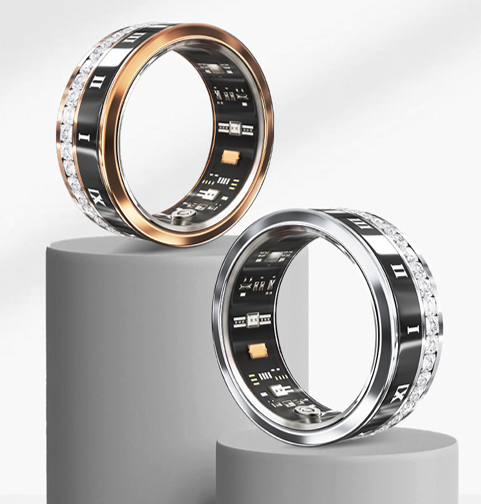How Smart Rings Improve User Health Management Experience
7/10/20255 min read


Introduction to Smart Rings
Smart rings are an innovative form of wearable technology designed to monitor various health metrics and enhance the user experience in health management. Unlike traditional fitness trackers and smartwatches, smart rings provide a more compact, discreet alternative that can easily blend into everyday fashion. The development of these devices has been prompted by the increasing need for efficient health-tracking solutions that do not compromise on aesthetics.
These sleek devices are typically constructed from advanced materials such as titanium, ceramic, or silicone, offering a combination of durability and comfort. The versatility in materials not only contributes to their resilience but also allows for a range of design trends that cater to varying style preferences. Many users appreciate that smart rings can be worn seamlessly alongside traditional jewelry, enhancing their outfit while simultaneously providing valuable health insights.
The evolution of health monitoring technology has been remarkable, transitioning from bulky devices to the sleek form of smart rings. Traditional wearables like wristbands and fitness watches have paved the way for this new generation of health-focused technology. Smart rings are now equipped with sophisticated sensors that can track a variety of health metrics, including heart rate, sleep patterns, and activity levels, providing users with an all-encompassing view of their health status.
This shift toward more compact and fashionable health-tracking options reflects a broader trend in consumer preferences for wearable technology. Users increasingly seek devices that offer both functionality and style, leading to a surge in the popularity of smart rings within the health management sector. Their appeal lies not only in their health-monitoring capabilities but also in their potential to encourage proactive personal health management, making them an essential tool for individuals seeking a modern solution for their health tracking needs.
Health Monitoring Features of Smart Rings
Smart rings have emerged as an innovative solution for health management, providing users with an array of health monitoring capabilities that enhance the overall user experience. Among their foremost features is heart rate monitoring, allowing users to track their cardiovascular health with precision. Utilizing advanced sensors, smart rings measure heart rate continuously, offering insights that are comparable to those from traditional wearables like smartwatches. This real-time data is invaluable for users seeking to optimize their exercise routines or manage stress levels.
Another significant capability of smart rings is sleep tracking. These devices utilize motion sensors and algorithms to analyze sleep patterns, providing users with detailed reports on sleep duration and quality. Unlike many other wearables, smart rings are designed to be compact and unobtrusive, ensuring a comfortable fit that encourages consistent usage throughout the night. This detail is critical, as understanding sleep quality can lead to improvements in overall well-being.
Activity tracking is also a prominent feature in smart rings, enabling users to monitor their physical movement throughout the day. Smart rings can record various activities, including steps taken, distance traveled, and calories burned. This functionality assists users in setting and achieving fitness goals by providing a comprehensive overview of their daily activities.
Moreover, smart rings often include blood oxygen level monitoring, a feature that has garnered attention for its role in assessing respiratory health. This non-invasive measurement informs users about their oxygen saturation, which is essential for maintaining general health, especially during high-intensity activities or altitudes. In addition, the integration of stress management features further distinguishes smart rings from other wearables, equipping users with tools to recognize stress levels and implement effective coping strategies.
Overall, the combination of continuous health tracking and real-time data access provided by smart rings enhances user engagement with their personal health management. This data-driven approach empowers users to make informed decisions, leading to improved health outcomes and a more proactive lifestyle.
User Experience and Interface
Smart rings are revolutionizing the way users interact with their health management systems, providing a seamless and intuitive user experience. These devices, which integrate advanced technology into a compact form, allow users to effortlessly monitor a range of health metrics, from heart rate to sleep quality. The interface of smart rings is designed with the user in mind, ensuring that even those with minimal technological experience can navigate their functionalities with ease.
One of the most significant advantages of smart rings is their ability to present data in a clear and concise manner. Using apps connected to smartphones, users can access detailed insights into their health data, all presented in an easily digestible format. This capability not only enhances user understanding but also encourages consistent engagement with health management practices. Additionally, smart rings often come equipped with personalization features that allow users to tailor notifications and metrics to their specific health goals and preferences.
The integration between smart rings and health applications on smartphones further amplifies the user experience. The connectivity facilitates real-time data sharing, enabling users to track their progress and receive timely feedback, which is crucial for effective health management. Feedback mechanisms, such as gentle reminders for hydration or warnings for exceeding heart rate thresholds, help users stay proactive about their health. User testimonials frequently cite improved motivation and accountability as key outcomes from adopting smart rings. For instance, a user noted a significant increase in their physical activity levels after the ring provided daily reminders and insights into their exercise patterns. Such case studies exemplify how smart ring technology can effectively empower users to take charge of their health and contribute to better health outcomes. smart ring.
Impact on Health Management Strategies smart ring
Smart rings have emerged as pivotal devices in transforming individual health management strategies. By integrating advanced technology and data analytics, these wearables provide users with actionable insights into their health habits. They monitor various health metrics including physical activity, sleep patterns, heart rate, and stress levels. With a focus on fostering awareness, smart rings encourage users to adopt healthier lifestyles, ultimately making significant contributions to their overall well-being.
One of the primary benefits of smart rings is their ability to seamlessly integrate with existing health management systems. This integration allows users to consolidate their health data in one place, facilitating easier tracking and analysis. For instance, health apps can synchronize data from smart rings, enabling healthcare providers to access real-time information and make informed decisions. This holistic view of health can lead to more personalized care plans tailored to the individual's specific needs.
Additionally, smart rings play a significant role in preventive healthcare. By providing continuous monitoring of vital health metrics, they can identify potential health risks before they escalate into serious issues. For example, an early warning system for irregular heart rates can prompt users to seek medical advice, thereby enhancing outcomes through timely interventions. This preventative approach not only empowers individuals to take charge of their health but also alleviates the burden on healthcare systems.
Looking toward the future, advancements in smart ring technology promise even greater capabilities. Innovations may lead to enhanced data accuracy, extended monitoring capabilities, and sophisticated algorithms for personalized health alerts. As these devices continue to evolve, they are set to redefine how individuals manage their health, empowering users with the knowledge and tools needed to make informed decisions about their health and well-being.
